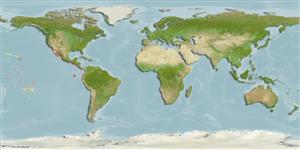Teleostei (teleosts) >
Pleuronectiformes (Flatfishes) >
Paralichthyidae (Large-tooth flounders)
Etymology: Paralichthys: Greek, para = the side of + Greek, ichthys = fish + Greek, suffix, oides = similar to (Ref. 45335).
More on authors: Jordan & Williams.
Environment: milieu / climate zone / depth range / distribution range
Ecology
Marine; brackish; demersal; depth range ? - 25 m (Ref. 55763). Tropical; 32°N -
Eastern Pacific: Mexico to Peru, including the Galapagos Islands.
Size / Weight / Age
Maturity: Lm ? range ? - ? cm
Max length : 80.0 cm TL male/unsexed; (Ref. 2272); common length : 50.0 cm TL male/unsexed; (Ref. 9330)
Adults are found in estuaries and up to 22 m depth (Ref. 9330), on sand or mud bottoms (Ref. 11482), common in some zones (Ref. 9330). They feed on fish (Ref. 28023). Marketed fresh or frozen (Ref. 9330).
Life cycle and mating behavior
Maturities | Reproduction | Spawnings | Egg(s) | Fecundities | Larvae
Distinct pairing (Ref. 205).
Hensley, D.A., 1995. Paralichthyidae. Lenguados. p. 1349-1380. In W. Fischer, F. Krupp, W. Schneider, C. Sommer, K.E. Carpenter and V. Niem (eds.) Guia FAO para Identification de Especies para lo Fines de la Pesca. Pacifico Centro-Oriental. 3 Vols. FAO, Rome. (Ref. 9330)
IUCN Red List Status (Ref. 130435)
Threat to humans
Harmless
Human uses
Fisheries: commercial; aquaculture: experimental
Tools
Special reports
Download XML
Internet sources
Estimates based on models
Preferred temperature (Ref.
123201): 20.2 - 29.1, mean 24.3 °C (based on 232 cells).
Phylogenetic diversity index (Ref.
82804): PD
50 = 0.5000 [Uniqueness, from 0.5 = low to 2.0 = high].
Bayesian length-weight: a=0.00646 (0.00290 - 0.01435), b=3.17 (2.99 - 3.35), in cm total length, based on LWR estimates for this Genus-body shape (Ref.
93245).
Trophic level (Ref.
69278): 4.5 ±0.80 se; based on food items.
Resilience (Ref.
120179): Medium, minimum population doubling time 1.4 - 4.4 years (Fec=220,000).
Fishing Vulnerability (Ref.
59153): Moderate to high vulnerability (52 of 100).
